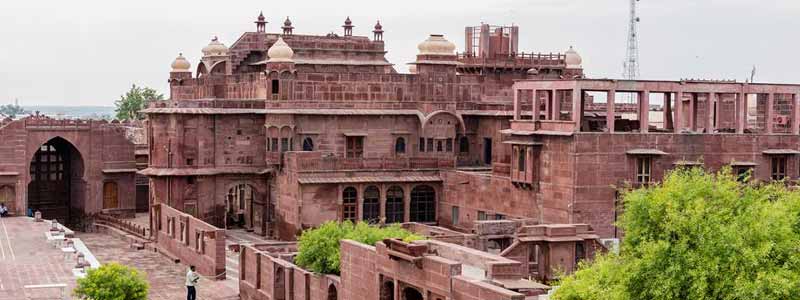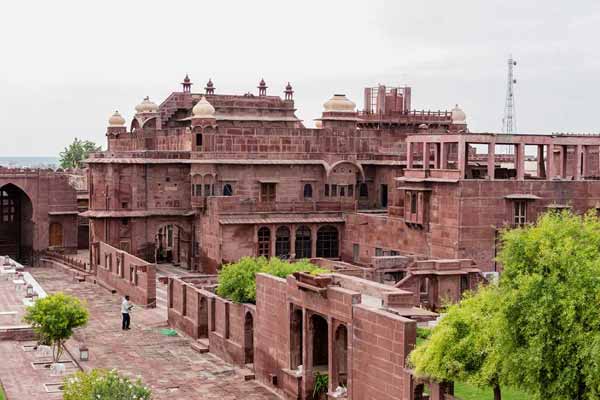Pokhran Fort, popularly known as Balagarh, is an ancient fortress built in the 14th century. The monument stands in the middle of the Thar Desert. It is historically situated on an old trade route through which spices, salt and silk were exported to Persia and other countries. It is the premier fort belonging to the chief of the Champawat of the Rathore clan. The glorious past and the history of the fort attract a number of tourists from different parts of India and abroad.
Travellers can see the beautiful red sandstone palaces, the conventional jharokhas and grand towers here. At present, Thakur Nagendra Singh Pokaran along with his spouse, Thakurani Yashwant Kumari Pokaran, have happily opened the gates of the fort for visitors. The fort is a splendid example of the Mughal and the Rajput styles of architecture Rajasthan Budget tours.
There is a museum in the fort displaying the royal collection of weapons, clothes, paintings and handicrafts. In addition, there is the Grand Library with a rich collection of classic books about the great Rao Bahadur Rajshree Thakur Chain Singh Ji Pokaran.

History of Fort Pokhran
Pokhran is a city and a municipality located in the Jaisalmer district of the Indian state of Rajasthan. It is a remote location in the Thar Desert region and served as the test site for India’s first underground nuclear weapon detonation. Balagarh fort was built by the Marwar Thakur, Rao Maldeo in the 14th Century, it is otherwise known as the Pokhran Fort. Pokhran means the place of five mirages enclosed by sandy, rocky, salt ranges. Although a small temple made of red sandstone, the fort is dedicated to Goddess Durga. It is situated in a remote region of the Thar desert which also served as a test site for India’s first underground nuclear weapon detonations.
The majestic fort has a huge door with sinister spikes jutting out to stop elephant stampede. It houses a museum displaying armoury, pottery, miniature paintings and costumes worn by the maharajas of the bygone era. Surrounding the fort is the village of Pokhran that welcomes every traveller with a warm heart. The local weavers and potters working at the market, safari over the sand dunes, a community that feeds the migratory birds are all the beauty of Pokhran.
The best time to visit Pokhran Fort in Jaisalmer is during the winter season which begins in the month of November and lasts till February. The rest of the year, Jaisalmer experiences extremely high temperatures keeping the deserts dry and arid. The mercury level fluctuates between a maximum of 31°C and a minimum of 7°C during the winter season. The average remains around 20°C, making it an enjoyable time to explore the Fort located in the midst of the Thar Desert. Summers and monsoons (from April to September) are not recommended because the average temperature is quite high, around 34°C during summers and 30°C during monsoons, and the region receives low amounts of rainfall.
Architecture of Pokhran Fort
The Pokhran Fort is a 14th century heritage monument essentially built with sandstone. The architecture is an amalgamation of Mughal and Indian Architecture. The fort consists of wide courtyards, pillars, arched porticos, Jharokas, Chhatris and domes demonstrating the blend of the two architectures. Not as massive as one may have imagined, but the Pokhran fort houses several palaces (Mahal), namely Mangal Niwas, Phool Mahal, Hawa Mahal and Rani Mahal.
A temple dedicated to Goddess Durga is also present on the premises. It has a traditional Hindu Temple Architecture and is as old as the fort itself. Amongst the palaces, Mangal Niwas, which is the main hall of the Pokhran Fort, is quite uniquely built with octagonal-shaped Jharokas that protrude out of the walls. The Mahals form a complex in the centre of the estate which is enclosed by a stone fortification which was built to protect the Fort from intruders.
Pokhran Fort has a museum and a library too. The museum has a collection of antiques belonging to the 14th century which include handicrafts, paintings, portraits, weapons, pottery, terracotta items, attires and apparels of the royal families etc. The library has a grand collection of books including classics, documentaries, journals etc. The interiors of Fort Pokhran are decorated with regal colours and patterns. Each part of the fort has a lush well-trimmed lawn, fountains and courtyards. The internal walls, arches and pillars bear beautiful carvings, mostly depicting the Mughal Style of Architecture.
Several rooms of the fort that have been transformed to accommodate the hotel guests have a blend of traditional and modern décor that consists of heavy wooden doors, ceilings made of carved wood, marble flooring, antique furniture, chandeliers, a swimming pool and modern bathrooms. The entire structure is also lit by contemporary lights and coloured in the hues that suit the yellow sandstone that the regal structure is made of Rajasthan Monuments.
Best Time to Visit Pokhran
The best time to visit Pokhran Fort in Jaisalmer is during the winter season which begins in the month of November and lasts till February. The rest of the year, Jaisalmer experiences extremely high temperatures keeping the deserts dry and arid. The mercury level fluctuates between a maximum of 31°C and a minimum of 7°C during the winter season. The average remains around 20°C, making it an enjoyable time to explore the Fort located in the midst of the Thar Desert. Summers and monsoons (from April to September) are not recommended because the average temperature is quite high, around 34°C during summers and 30°C during monsoons, and the region receives low amounts of rainfall.
How to Reach Pokhran?
By Air – Jaisalmer airport at the distance of 142 km is the nearest airport to reach Pokhranby air. You can take a taxi or bus from Jaisalmer Airport to Pokhran. Jodhpur is another option at the distance of 208 km to reach Pokhran.
By Train – Ramdevara Railway Station is the nearest railway station to reach Pokhran. Distance between two cities is 21 km that can be covered by bus or taxi. Jaisalmer is another option at the distance of 132 km from Pokhran.
By Road – There are regular buses from Jaisalmer and nearby cities to reach Pokhran by Road. You can take a bus or taxi or reach by your own vehicle.
